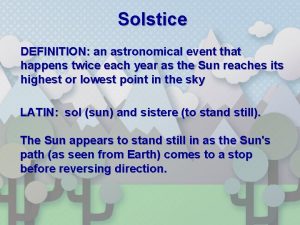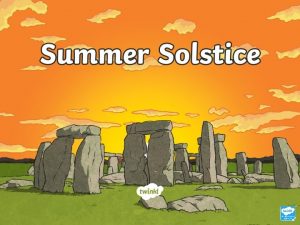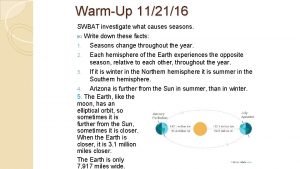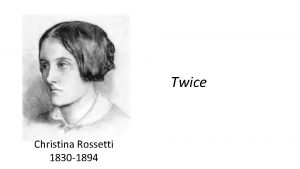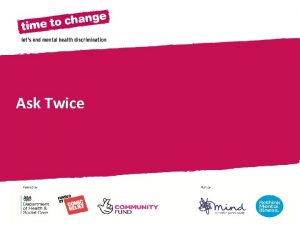Solstice DEFINITION an astronomical event that happens twice






- Slides: 6

Solstice DEFINITION: an astronomical event that happens twice each year as the Sun reaches its highest or lowest point in the sky LATIN: sol (sun) and sistere (to stand still). The Sun appears to stand still in as the Sun's path (as seen from Earth) comes to a stop before reversing direction.

Solstices • Solstices occur twice a year, when the tilt of the Earth's axis is oriented directly towards or away from the Sun, causing the Sun to appear to reach its northernmost and southernmost extremes. • Winter solstice is the shortest day of the year. In the Northern Hemisphere. It occurs on December 21 and marks the beginning of winter. • The Summer Solstice is the longest day of the year. It occurs on June 21 and marks the beginning of summer. Tyrrhenian Sea and Solstice Sky Credit & Copyright: Danilo Pivato

SOLSTICE • During the winter the Northern Hemisphere day lasts fewer than 12 hours and the Southern Hemisphere day lasts more than 12 hours. • During the winter solstice, the North Pole has a 24 -hour night and the South Pole has a 24 -hour day. • Sunlight strikes the earth most directly at the Tropic of Capricorn. http: //k 12. ocs. ou. edu/teachers/ref erence/solstice. gif

Equinox DEFINITION: When the tilt of the Earth's axis is inclined neither away from nor towards the Sun LATIN: The name "equinox" is derived from the Latin aequus (equal) and nox (night). During the equinox, night and day have approximately equal length.

Equinoxes • A day lasts 12 hours and a night lasts 12 hours at all latitudes. • Equinox literally means "equal night". • Sunlight strikes the earth most directly at the equator. • This occurs twice a year. http: //k 12. ocs. ou. edu/teachers/reference/e quinox. gif

Equinox • The vernal (spring) equinox occurs March 21. • The autumnal (fall) equinox occurs September 21.
